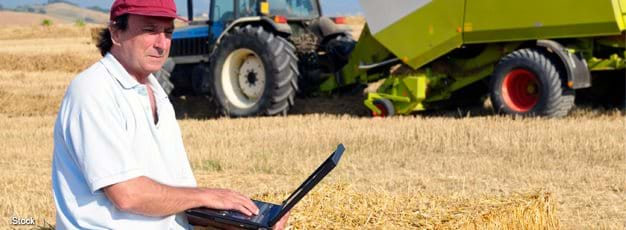Profit Margin Increases With Farm Size

Given the broad USDA definition of a farm, most U.S. farms are not profitable as ongoing businesses. One commonly used measure of profitability is the farm’s operating profit margin (OPM), the ratio of operating profit to gross farm income. Operating profit measures funds available to finance the farm’s ongoing operation after deducting the estimated market value of the unpaid labor and management services provided by the farm household. A farm is considered to be in the “critical zone,” indicating potential financial problems, if operating profits comprise less than 10 percent of the farm’s gross cash farm income (GCFI) from the sale of commodities and other farm-related goods and services, together with Government payments.
While 69 percent of all U.S. farms were in the OPM critical zone in 2013, 87 percent of these farms have GCFI of less than $100,000. Low profitability for smaller farms is not a recent development. For example, 15 years earlier, in 1998, 69 percent of farms were also in in the critical zone, four-fifths of which had GCFI less than $100,000 (measured in constant dollars).
Larger farms are more likely to be profitable than small farms (those with GCFI of less than $350,000), reflecting economies of size in farming. Smaller farms in the critical zone typically do not earn enough from the sale of farm commodities and ancillary services to cover expenses: cash expenses exceed cash receipts for the 70 percent of the farms with GCFI below $100,000 that are in the critical zone. The share of farms in the critical zone is especially high for retirement, off-farm occupation, and low-sales small farms—which together account for 98 percent of farms with GCFI less than $100,000—but tapers off rapidly for larger farms.
A relatively high percentage of nonfamily farms are also in the critical zone, reflecting the small size of most nonfamily farms (two-thirds have GCFI less than $100,000). An example of a small nonfamily farm would be a farm with GCFI less than $350,000 owned equally by two unrelated partners. Most nonfamily farms are not large corporations. Seventeen percent of nonfamily farms are organized as corporations, and only 8 percent of these farm corporations have GCFI greater than $5,000,000.
Given the high share of small farms in the critical zone, how do so many small farms continue to exist? Many operators stay in business by undervaluing their labor, effectively ignoring the implicit value of the unpaid labor and management they provide. Such small-farm households typically receive substantial off-farm income and do not rely primarily on their farms for their livelihood. They often use off-farm income to cover farm expenses and make investments in their farm operations.
Nevertheless, not all small farms are unprofitable. For example, 14 to 33 percent of each small-farm type has an operating profit margin of at least 20 percent. Even greater shares of larger family farms have a profit margin that high: 46 to 64 percent of midsize (GCFI of $350,000 to $999,999), large ($1,000,000 to $4,999,999), and very large ($5,000,000 or more) family farms.
| Farm typology group | Farm size, measured by annual GCFI2 | Operating profit margin1: less than 10% (critical zone) |
Operating profit margin1: 10% to 19.999% |
Operating profit margin1: 20% or more |
|---|---|---|---|---|
| All farms | Not applicable | 69.3 | 4.7 | 20.4 |
| Small family farms (less than $350,000) | ||||
| Retirement | Less than $350,000 | 64.1 | 4.4 | 22.7 |
| Off-farm occupation | Less than $350,000 | 75.4 | 2.9 | 13.9 |
| Farming-occupation: | ||||
| Low-sales | Less than $150,000 | 76.2 | 3.6 | 16.0 |
| Moderate sales | $150,000 to $349,999 | 55.8 | 11.5 | 32.5 |
| Midsize family farms | $350,000-$999,999 | 41.6 | 12.6 | 45.8 |
| Large-scale family farms ($1,000,000 or more) | ||||
| Large | $1,000,000-$4,999,999 | 28.4 | 13.1 | 58.5 |
| Very large | $5,000,000 or more | 24.6 | 11.5 | 63.9 |
| Nonfamily farms:3 | Not applicable | 59.1 | 5.1 | 33.8 |
| Note: The farm typology focuses on family farms, where the majority of the farm business is owned by the operator and relatives of the operator. Family farms are sorted into more homogenous groups based on farm size—measured by gross cash farm income (GCFI)—and occupation of the operator, with retirement counted as an occupation. 1Operating profit margin (OPM) = 100% X (net farm income + interest paid - charge for operator and unpaid labor - charge for management) / gross farm income. OPM is based on both cash and noncash items. The ratio was not calculated for the 5.7 percent of farms where the denominator—gross farm income—was 0 or negative. 2Gross cash farm income (GCFI) is the sum of the farm's crop and livestock sales, Government payments, and other farm-related income. It includes only cash income. 3Farms where the majority of the business is not owned by the operator and relatives of the operator. Source: USDA, National Agricultural Statistics Service and Economic Research Service, 2013 Agricultural Resource Management Survey. |
||||
Structure and Finances of U.S. Farms: Family Farm Report, 2014 Edition, by Robert A. Hoppe, USDA, Economic Research Service, December 2014

